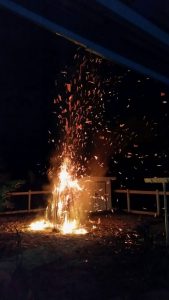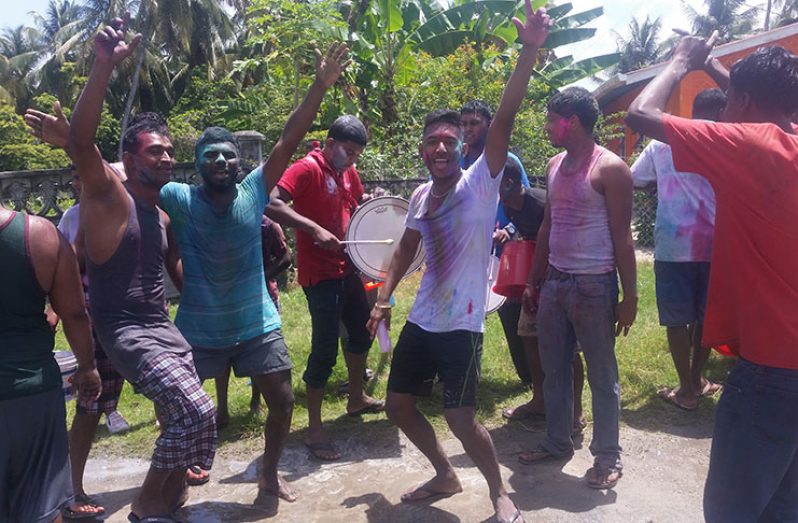By Indrawattie Natram
TODAY, Hindus the world over are putting their differences aside and joining each other in celebrating the much-anticipated festival of colours, Phagwah, also known as Holi.
Of all the various Hindu festivals, Holi somehow manages to generate the most interest, especially among young people.

Holi is a very fun-filled and popular occasion all across Guyana. It is a time when people smear each other with brightly coloured powders, known as Gulal or Abir (Abheer), and coloured water. The celebrants believe that the bright colours represent energy, life, and joy.
Here in Guyana, various activities are planned by various Sabhas, as the various Indian cultural groups are called, to usher in the festival that also signifies renewal and spring, and these activities have all become part and parcel of the festival.
THE PREPARTION
To start off the festival, preparations are usually made on the eve of Holi. Huge bonfires are burnt as a symbol of its representation, and to ward off evil spirits.
Many women are determined to clean their homes, since in the Hindu tradition, Holi is considered the ‘New Year’, and should find their homes and surroundings clean and tidy.
Before the start of the festival, shopkeepers busy themselves, selling Gulal, as the coloured powders are known, and it is no surprise that the shops are flooded with festive shoppers. In preparation for the festival, new clothes are also bought for the family. It is a tradition for mothers to buy new clothes for their married daughters. And since colour is the main highlight of this festival, you will find young ladies and housewives in various villages wearing white dresses so as to aptly showcase the different colours of spring seasons.
Eco-friendly Holi powders made from the extract of flowers bloomed during the spring season, are also purchased from various markets, shopping centres and malls.
THE DAY ITSELF
On Holi, mothers let their children go out on the streets to indulge in the splashing of colours. Men like to wear white Kurtas, while the ladies prefer to wear white saris, or the Shalwar Khameez on Holi.

During the jollification, young maidens armed with syringes filled with sweet-scented colured water will drench the young men, letting none escape the powerful spray as the procession moves along the streets. Friends will shower each other with sweet-smelling coloured powder until it forms multi-coloured clouds overhead. Persons from mandhirs would normally visit homes, singing Holi songs and thoroughly enjoying themselves.
Families, friends and neighbours from the various Mandirs normally gather in a particular area, such as a garden, lawn, small playground or terrace and decorate that area with Samiyana and loud speakers for the festival.
Large tables are arranged with heaps of colourful gulal or abbera so that everyone can enjoy, by applying “Holi” on each other.
Dancing and singing is also a main part of this festival, when everyone can be seen involved in this festive spirit by drinking glasses of fruit drinks or ginger beer, while having sweetmeats or dried fruits. Mandhir members can also be seen dancing to the different tunes of folk songs and the rhythmic music of the dholak in the streets.
COUNTRYSIDE
For the children, particularly in the countryside of Essequibo, Holi celebration includes lots of enthusiasm and joy. They start the preparation for Holi a week before the actual celebration.

Children will be seen buying water guns, small buckets and various colours of powders. They also gather with other children from other communities in an allotted place where the festival can be enjoyed in full spirit. Many will use the opportunity to fill balloons with water so they can throw them on each other.
At lunch, housewives will prepare some special traditional Holi dishes such as Vegetable Pokara, Aloo Roti, and the popular seven-curry.
Delicious sweetmeats such as Kaju Barfi, Peda, Motichur Laddoo are also prepared. One thing that is very attractive about this festival is the spirit of the people who celebrate the occasion. Whether they are young or old, all the people are lost in the revelry, having fun throwing colours and water balloons at each other and even the occasional passer-by.
The Guyana Hindu Dharmic Sabha, Essequibo Coast branch, always organises the Chowtal Sameylan, which activity is held before the burning of the sacred Castor Oil plant, and the following week the grand Mela is welcome by everyone.
The Grand Mela is usually held at the Anna Regina Community Centre on Phagwah weekend, and sees thousands of persons gather to celebrate the occasion in the true spirit of friendship, joy, merriment and love.
Welcoming the festival of colours, Mandhir leaders throughout the county can be heard practising Chowtaal and Holi songs, while clashing their Jhals together, creating space for the season. Popular Chowtaal songs such as “Shiva Shankar” and “ Ragunandan” can be heard from a distance, echoing during the forty-day period.
Meanwhile, the farmers are busy harvesting during “Basant Ritu”, the spring festival. Many farmers normally take the grains harvested from their fields to make offerings to the scared fire (Agnie) on Phagwah Day at the various temples. When asked why this is so, old farmers usually say it’s a tradition inherited from their forefathers who came here as indentures labourers, and that they believe offering grains during the festival brings success and financial gain.
The Hindu societies in different schools also hold their own special Phagwah programme, enlightening students and widening their knowledge about the festivals.
During this festival, children expecially enjoy drenching each other and smearing abeer and abrack on one another’s face. The festival also fosters closer relationship among children and their peers, as it enables them to appreciate another aspect of life’s many cultures.
FOSTERING TOGETHERNESS
Over the years, the festival has grown with more and more significance to the Hindu

population. It creates a true sense of belonging and togetherness, and signals that as a people and nation, we are all one. Many persons, young and old, will converge at a central point where the pyre is built over the Castrol Oil tree, creating a true spirit of unity. Many, whilst witnessing the burning of the pyre enclosed with branches, will make their wishes, silently asking the God of Fire, Agnie, to burn all negativity away, as Holika (Hyranya Kashipur’s sister) was consumed in the fire instead of Prahalad.
Early in the morning on Phagwah Day, two men from the various villages will be sent to rub the ashes from the burnt Holika on each person’s forehead throughout the village before the frolicking begins. The ash represents renewal, hope and confidence in life.
At the end of the festivity, the Chowtaal goles from the different mandhirs will meet and formally end the season. Thereafter, the Sumiran of the Ramayan is chanted and Goles return, singing the Ramayan Bani to their homes.




.png)









